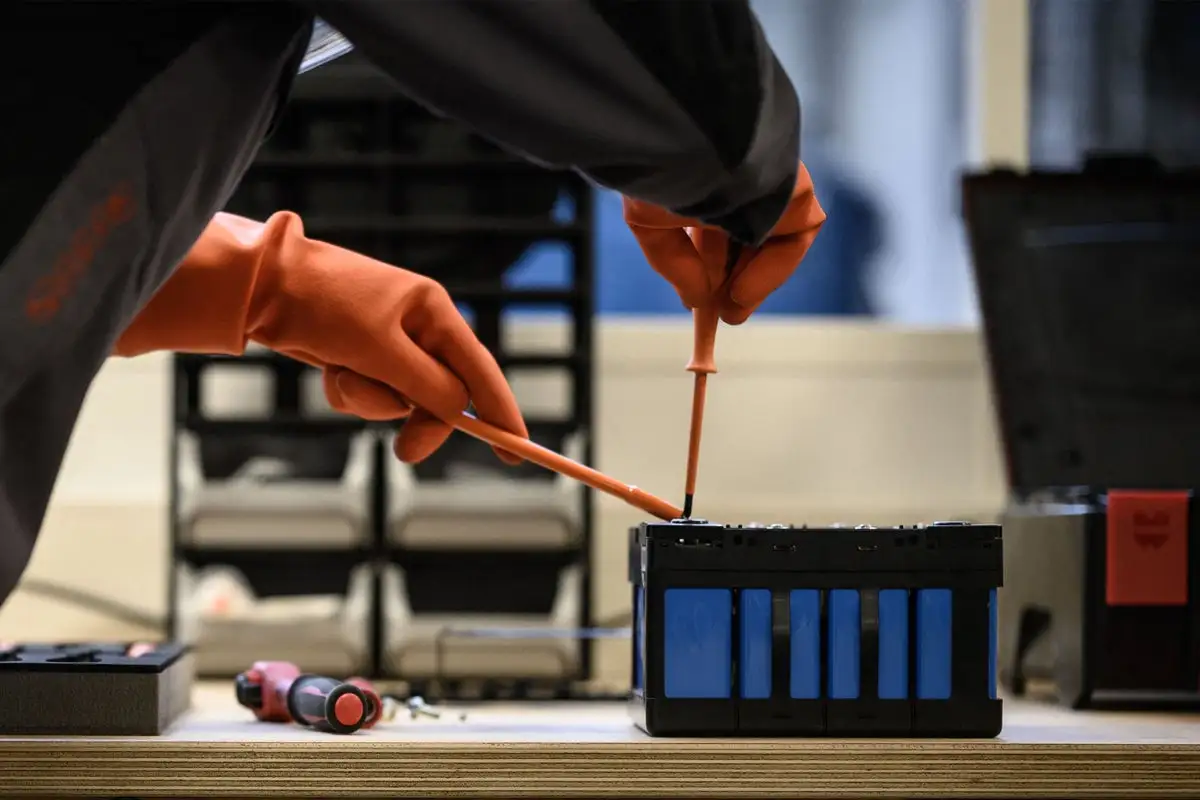Fixing car and e-bike batteries saves money and resources, but challenges are holding back the industry
Jacking Up a Car Is Dangerous. Here’s Why Mechanics Are Doing So Anyway
M.O.N.E.Y.
Yep. Other than thrill seekers, the only reason any business does something is for the money. If you can go, “Hey, you don’t need to spend $12k on a new battery pack! Bring it down to Bubba’s Batteries Bazaar and we can fix it for less!”, you will get business.
Yeah, thats pretty much it. Doesnt VW repair or recycle their own batteries?
C.R.E.A.M.
I suppose jacking off a car is also dangerous.
Depends. Are you a dragon?
Wasnt there subreddits for that?
Not that I know of.
There is dragonsfuckingcars.
You wouldn’t download a car… And if you did, you wouldn’t jack off a car…
Eh. That’s not really comparable to lithium-ion batteries. Lithium-ion batteries are similar to bombs in that they’re highly dense stores of energy. If something goes wrong and that energy storage medium gets exposed to air, or there’s a failure in a charging safety mechanism, that’s a chemical fire at best, explosion at worse, but no matter what, it’s extremely toxic.
Acetylene and oxygen is also explosive, but you’re still allowed to have it and use it. Battery acid is extremely corrosive and poisonous. Gasoline is extremely flammable. A garage is filled with dangers. If you can’t service a lithium-ion battery in a safe way, you shouldn’t do it, just like you shouldn’t service your brakes if you don’t know what you’re doing.
Lol. A single gallon of gasoline contains approximately 34khw of energy. An EV with ~300 miles of range, will have a battery with between 80 and 100 khw. Or the same potential energy as about 3 gallons of gas.
People are familiar with gas, so it seems safe. But every gas tank is a literal bomb, and that’s just for a car. I have no idea how big the storage tanks at gas stations are, but I’m assuming there’s enough explosive in there to level a couple hundred square feet if one of those goes.
Lead-acid batteries also present a risk of explosion.
https://en.wikipedia.org/wiki/Lead–acid_battery#Risk_of_explosion
That’s why you attach jumper cables to the dead battery first.
A car sitting 6 feet in the air is also a highly dense storage of energy that could be released at any moment. I do get your point, but there are ways to mitigate the dangers associated with working on a pack, and they’re not as volatile as you think. Being exposed to air isn’t going to cause a cell to explode as the lithium is mixed with other chemicals inside the cell to make it fairly inert. The danger comes from short circuits, whether it be a puncture or bridging contacts with something conductive.
Have you ever attached jumper cables to a dead lead-acid battery?
https://en.wikipedia.org/wiki/Lead–acid_battery#Risk_of_explosion
The whole repair thing should made super easy if we want EVs to succeed.
- Make all batteries use an easily swappable set of standard cell sizes.
- Make battery controllers standardised and swappable.
- …. Er… that’s it.
But that will never happen because the EV manufacturers couldn’t charge ridiculous amounts of money for proprietary batteries.
That why we need regulators. The market doesn’t magically deal with “Tragedy of the Commons”.
no that’s communism
No one lives in completely unregulated capitalism. Well, not willingly anyway. That kind of anarchy happens when countries collapse. But normally you quickly get a drug/war lord taking over setting their own (unfair) laws & regulation.
It’s a constant battle of over/under regulation, regulatory capture, etc. But that’s how it should be in a dynamic world.
I think they’re being sarcastic, but it’s annoying in its own way to repeat the lines that barely anyone actually believes
There are no shortage of those who really believe that nonsense. In the UK, we literally had a pair of these loonatics running the country and economy for a few months. They tanked the pound in their short time before their own party pulled the plug under pressure of markets and donors losing money.
God forbid that they concentrate on the quality of the basic vehicle instead.
Yup… If you can’t compete add tariffs.
But you know gubmint regjuleshons are stifling innovation.
Make all cars rechargeable with a single charging port. And that port should be USB-C
like 50 USB-C cables tied together to output enough of a charge lol
The highest available now is 240 W, so with 50 in parallel you get 12 kW. Fast chargers go up to like 300 kW but at home 12 is good enough actually.
I’ve been surprised by USB-C. I recently bought a Xiaomi phone and it takes like 10 minutes to charge with the charger that comes with the phone (and it still works with the other ones). It’s 120 watts
At that rate it’d still take 12 hours to charge a 1440 watt hour battery, which isn’t the hour or two that people are used to with superchargers these days, but actually surprisingly servicable.
That’s 50x smaller than an EV battery. Being able to drive once every two months doesn’t seem practical.
Where did you pull that 1440Wh number from? The battery in my plug-in hybrid is 20kWh, and that’s still small compared to a full EV.
Ah shit, I googled the number but it looks like I got the number for a battery in an internal combustion engine car, apologies. I’m an electronics person, not a car person
Understandable. Just for the sake of comparison to a smartphone 120W fast charger, level 1 EV chargers (which can still take days to fully charge a completely drained EV) will generally deliver between 1000 and 1500W. Level 2 (the fastest you’ll typically see installed in people’s homes) range from about 7kW to 19kW. Level 3 fast chargers typically operate from about 60 to 250kW and unlike level 1 and 2 which deliver AC to the car to be handled by the vehicles internal rectifier/charger, level 3 delivers DC.
1.44kWh Is roughly 7-10km of driving, depending on the car and weather. In 12h that’s an absolutely useless amount of power for anything other than small e-scooters and short-range e-bikes.
Can’t wait for all power cables to just be USB-C. I dream for the day where I can charge my phone with the same plug my induction stove uses.
If USB-C isn’t powerful enough, I’ll settle for a Lightning connector.
The one in / from back to the future should be sufficient.
I’ve said it before, and I’ll say it again allow… cars with CATL or Nio battery swap cassettes into the US… It is so dumb that there are different battery setups for every manufacturer … In a Nio I can swap batteries for less than a pack of beer… Why not do that instead of this current BS system where you have only one pack and once that is done it is $10k
Looks like for some Ioniq 5’s it’s 60k - more than a new car.
I also saw that video (note $60k CAD about $42k USD). Hyundai is really going to need to figure things out if they expect Ioniq 5 sales to continue because insurers aren’t going to keep paying out $60k every time someone drives over some road debris and customers aren’t going to be happy about insanely high insurance bills or paying more than the MSRP of their brand new car to replace a single component.
I wonder if the prices are due to Hyundai having supply chain issues and designating every pack toward new vehicles.
I heard NIO has this technology already and are looking to standardise it.
Every EV has this already. What they don’t have is a standard. Not shockingly, every EV manufacturer will argue why theirs should be the standard.
Honestly if the department of defense adopts any EVs for troop transport it should come with a forced standardization. Just hand wave it as being for national security and the fact a lot of countries will probably adopt the standard, that should do the trick.
They probably won’t. Unless it will cut costs and allow for speed of refilling/recharging. Maybe in another 50 years. And only if one of the big firms tries to sell them something. Lockheed or Boeing or so on. The problem is troop transport needs to be fixable by a shop of people ranging in age from 17 or so to around 25. Inexperienced people. In a fair few cases with hand tools. To even remove a battery from an EV right now you need a lift of some kind and something stable to drop it onto. You can’t carry that into the desert. Certainly not onto an aircraft carrier. And we’re awhile away from building it into war ships, even smaller ones. The output and range would have to be reliable. A pilot can’t rely on a bingo that doesn’t accurately tell him if he has enough fuel to get to the target and back.
The problem with this is that every vehicle would need to be built around the same battery pack dimensions, have the same amp-hour rating, same voltage, same cooling system, etc. I seriously doubt that would ever happen as nothing like that has ever existed in the 120+ years of automotive history.
The problem with this is that every vehicle would need to be built around the same battery pack dimensions
There’s a lot of ways to tackle this issue. You could have a couple of standards (think AA vs AAA batteries). Or you could make the packs smaller and more modular so different applications can have more or less of them.
have the same amp-hour rating
No, they’d not need that. In fact, I’d say it’s desirable for them to not have that.
same voltage, same cooling system
Same voltage, yes, same cooling system? Not exactly. They’d just need to have cooling system hookups in the same place.
I seriously doubt that would ever happen as nothing like that has ever existed in the 120+ years of automotive history.
Loads of things like that have existed in the automotive industry. In fact, that’s one of the biggest features of the big 3 automotive manufacturers is having standardized parts shared between one another.
I’m not so sure.
Are we talking about the same thing, there was a recent Tom Scott video on it.
Basically you drive your NIO into this machine and it removes your battery and replaces it. Then it charges your old one and next time someone drives in they may get your last battery. Since and repeat.
Standard and swappable battery packs? Yes. All the skateboard style vehicles or ebikes have battery packs that can be removed and replaced.
Making that automated could be nice but isn’t necessary to get the benefits of a standard. A standard forces pack producers to compete with one another in terms of quality and price. It makes it cheaper to install new batteries. And it makes it possible to upgrade your cars range with newer packs. With an EV, you won’t need to get a new vehicle hardly ever if getting new packs is relatively affordable and easy. Further, the worn packs still have value so swap locations will be incentivized to pay you for the pack they remove.
The notion this needs to be part of a giant battery swapping network to reduce charge times is silly. 10 to 15 minute charge stops are already very short and all you need on most cars for the next leg of a journey. It also introduces a lot of complexity. Like, what if I want or need a 100kWh pack but the standard is 80kWh packs? What about pack wear? Who’s in charge of pulling the degraded packs? And what do we do about someone putting in a pack with fake capabilities? You have a situation where you are cycling parts worth well north of $10k. That’s a mighty tempting target for theft.
A standardized battery is still a really good thing. I just don’t think it needs to be a part of road trips.
that’s not what the top comment was talking about. this is replacing the whole battery, not cells within the battery. it doesn’t help with reparability at all.
This was posted to one of the communities I sub to a day ago: https://spectrum.ieee.org/flow-battery-2666672335
This would probably be the best option if it takes off.
Is it money?
Is it money? I bet it’s money
Mostly it’s money for the consumer. I have a Prius so it might be a little different. But when the hybrid battery goes out costs something like $7,000 to have it replaced. A mechanic in town will repair it for $1000.
Now my car isn’t worth $7000 so if I had to replace the battery then I would just get a new car and this one might end up in the scrap heap. In getting it repaired I have gotten something like 6 more years out of it, at least, and that’s a pretty significant environmental savings.
And that’s essentially what the article is saying.
A battery that is utter trash for driving purposes still has tons of life left for other uses.
So it is about money.
Manufacturers will keep making their cars hard to repair cos they want all the money of the customers in original replacement parts. Their cars are specially designed to only be repaired by their own technicians, they want the whole business you know.
Unless it’s a Nissan, then forget a repair – it’s an all out replacement every time. Don’t buy a Leaf.
ChrisFix did it on a Toyota: https://www.youtube.com/watch?v=oAHaYXBFnJo
A Subscription Is Required to Continue Reading
A Subscription Is Required to Continue Reading
Interesting.
First of all apparently ublock, no script, or some combination of my add-ons kept me from seeing the message and I’m able to view the entire article.
Even more interesting is this text at the end of the article-
This story was originally published by Grist, a nonprofit media organization covering climate, justice, and solutions.
So this source basically spun an article from Grist and put it behind their paywall.
Following the link from Scientific American, the first line of the Grist article is-
This story was co-published with WIRED.
It’s clowns the whole way down, yaaaaar.
We should all strive for this level of rigor when understanding sources of articles online.
The world would be so much better.
A Continuation is Read To Require Subscription
Worked fine for me! I’m not a subscriber to SA.
Because that’s literally a mechanic’s job.
I loved how Renault solved this for the Twizzy (and other cars). You bought the car. You leased the battery for something like 50 euros a month. (Probably more now).
Sure, that sounds expensive, but I suspect it worked out less than replacing the battery after a decade.
Suspect it also helped resale value. The most expensive repair to worry about for a second hand buyer, is the battery. Making that a lease removes that worry entirely. You know exactly how much it’s going to cost.
Of course, having to pay that monthly lease fee for the battery, does make it more obvious that electric cars aren’t necessarily that much cheaper to run than an ICE.
I’ve got enough subscriptions in my life. 50 euros a month would be 6000 euros after 10 years (figure a couple years more than the 8-year warranty in the US) that could be put towards a refurbished battery if the car needed one at that point. The reality is, on a 10-year-old car, a little range degradation isn’t a huge deal, especially if that car is being driven around town and can be charged nightly. I’d rather own the things I buy, and not pay to be tied into yet another monthly bill.
Plus imagine if you crash or sell the car after 5 years and then lose $3k for nothing.
Somehow I only now got a notification about this. That brings up an interesting point: would you be financially liable for a battery damaged in a crash? I would imagine insurance would cover it, but you’re paying your premium based on that value, only to have to give a big portion of any claim payment back to whoever you’re leasing the battery from
We have an BMW i3. 8 years old. Battery is fine. But car is written off now because the inverter failed. 11k€ repair. Worst part is that due to BMW software locks it’s almost impossible for third party repair to work on the car. Any replaced part needs to be “blessed” by BMW.
That’s the bullshit we should be focusing on. And not only in the EV space. See John Deere
whatever happened to Teslas distributed powergrid? Now that was a game changer, offloading the cost of the battery entirely could have made EVs actually affordable.
It’s up and running for the Powerwall, on some grids anyway (it works in my state - but depends on having an agreement with the grid).
The thing is there needs to be coordination between your battery and the grid - you don’t to drain your battery every night, they only last about 4,000 cycles.
If every home in the state had a Powerwall, then maybe it could help provide baseload power but the reality right now is all it can do is help with temporary disruptions, for example keeping the grid up when a cloud passes over a major solar farm.
They’re in the planning stages of doing Vehicle to Grid or V2G power. Right now though, it’s just for standalone batteries. This isn’t just Tesla by the way - when it comes it’ll likely be for most EVs.
EVs are still much cheaper to run than ICEs though. Yes the battery is an expensive replacement but maintenance is still much cheaper because they don’t have gearboxes, clutches, turbo chargers, catalytic converters, particulate filters, spark plugs, engine oil, timing belts, head gaskets, cylinders, exhausts, etc. etc.
It’s cheaper, but not that much cheaper. Anecdotally, my current car is 8 years old and has cost me roughly 400 euros a year in repairs and servicing. Manual gearbox is fine and should outlast the car.
Also, if I do a simulation for extended warranty and servicing (8 years/210k km) on the manufacturers website for a petrol car and for an equivalent electric car, the difference is roughly 600 euros per year. I suspect that’ll be down to the battery. Traditional car the costs are spread over a longer period. Electric the battery or whatever sneaks up on you. The whole thing becomes doubly annoying when you factor in high electricity prices, meaning (sometimes) fuel costs are lower than electricity costs.
To be clear, electric is the future, it’s a good thing they’ll be banning the sale of new ICE cars here in the foreseeable future, and an electric car almost certainly is cheaper to run. It’s just not _that _much cheaper. I assume prices will come down when they’re forced to start making more of them and competing with the Chinese.
Danger, Danger, High Voltage!
Although it annoys me that mechanics consider even 400V “high” voltage. HV is supposed to be 1,000V, minimum.
400V is dangerous though. The traditional 12V is not.
Absolutely, but 400V isn’t as dangerous as 1,000V. IEC standards have already established all of this, above 1,000V is HV, below 50V is ELV and generally safe. Automotives have come in and labelled anything above like 24V as “HV”, which is just silly.
deleted by creator
LMAO
Removed by mod
You should see what happens to actual mpg in the rain vs in the dry. Its almost like MPG can vary wildly dependent on environment and situation
Yeah the whole range issue is dumb to me. You can recharge it so what’s the issue? I recharge mine on long trips and stop to eat at the same time. Who are all these people that want to sit in a car for over 400 miles without stopping? That sounds worse lol I always stopped with my case car to eat or pee anyways. If I stay 30 min to an hour I can get fully charged too.
Also the benefits of never needing to stop to charge or fuel when I’m just driving around town. I can go all over and not need to charge my car for a few days. Then I do it when I sleep.
Also single pedal driving was new to me and I love that! It is so much more responsive if I want to stop I just stop going lol I love it. It has crazy torque too and makes a fun spaceship sound when I drive around.
Depends on where you live and where you plan to go with it. Our EV at current range is fine to get to the nearby large city in the summer over a fairly long stretch of highway. In winter it would probably be doable but at the least it impact our stopping/charging schedule. At 70% range it might not be doable at all in winter and we’d have to be careful in summer. Governments pushing EVs absolutely should be pushing a reasonable recycle/replacement cycle for batteries and the infrastructure to support that.
You misunderstand me. I’m saying that unlike ice vehicles that will continue to get about the same mpg for the life of the vehicle, lithium batteries degrade with every charge/discharge cycle. When an electric is new and you buy one with enough range to suit your needs, every year you own it the max range on a full charge is reduced. So an ev with 120,000 miles on it that started off being able to go 300 miles max will now only go about 250 miles max. The batteries lose capacity. The federally required 8 year 100k mile warranty on batteries only covers if the capacity of the battery is less than 70% of the original capacity. Typically though, evs are usually in the range of 80 to 90% capacity at the 100k point. They don’t start dropping off hard until they’re closer to around 200k and over 10 years old most of the time. Total failure due to dead shorts in too many cells has been happening around the 14 to 18 year area. That’s when you decide to sell it for $3,000 or pay $15,000 to install another battery.
Total failure due to dead shorts in too many cells has been happening around the 14 to 18 year area. That’s when you decide to sell it for $3,000 or pay $15,000 to install another battery.
If I get to 14 to 18 years on a car without every having to replace an engine, transmission, it never gets in a crash that writes it off entirely, and its still worth $3k at the end I consider that a win.
My old Volvo is 43 years old and has never had engine or transmission changed. It’s gone for 350,000 km and is still going strong. Is probably worth somewhere in the region of $2k. I don’t see any of the cars made today managing the same feat.
That’s straight up survivorship bias
Here’s the summary for the wikipedia article you mentioned in your comment:
Survivorship bias or survival bias is the logical error of concentrating on entities that passed a selection process while overlooking those that did not. This can lead to incorrect conclusions because of incomplete data. > Survivorship bias is a form of selection bias that can lead to overly optimistic beliefs because multiple failures are overlooked, such as when companies that no longer exist are excluded from analyses of financial performance. It can also lead to the false belief that the successes in a group have some special property, rather than just coincidence as in correlation “proves” causality.> Another kind of survivorship bias would involve thinking that an incident happened in a particular way because the only people who were involved in the incident who can speak about it are those who survived it. Even if one knew that some people are dead, they would not have their voice to add to the conversation, making it biased.
Removed by mod
and most that aren’t is due to accidents.
You’re making my point for me. The likelihood a car, any car BEV or not, is going to make it to your (unproven) theoretical point of being a problem is 1 in 4.
If your premise is that BEVs are good up until the 200k mark, then you’re making a bad bet on your ICE or Hybrid needing to survive to the 200k mark to be worth it. With your numbers I have a 75% chance of being right, while you only have a 25% chance, and that’s even if I agree with your premise (which I think is a bit suspect).
Removed by mod
It’s because people are uneducated and naive about the batteries and how assuredly a well built one will still fail and pretty soon the general population will wise up to it and old ev prices will dive.
Gotcha, so we’ve exited the discussion on proven fact and you’re well into your personal speculation. Thanks for the discussion up to now. Have a great day!
But what does that number even mean? There are also 278 million vehicles registered in the US and only 233 million registered drivers, so I’m betting a lot of those 16+ year old vehicles aren’t people’s primary mode of transportation. I spend 2-3 hours commuting on the freeway and certainly don’t see 1 in 4 being 16+ years old. My own car is 10 years old now and I would say it’s on the older side of what I typically see.
I have three working vehicles. Four if you count my motorcycle. Two are 16 years old. A prius and a sienna. One is 18 years old. A mazda tribute. My motorcycle is 28 years old. A Suzuki bandit. I don’t even own a vehicle newer than 16 years old. Did just junk an 18 year old Nissan altima because my 16 year old kid blew up the engine after way over filling the oil.
Chances are you aren’t seeing 1 in 4 vehicles on your route that are over ten years old. But part of the reason (but not all the reason) is the same reason you never noticed how many of the vehicle you drive were out on the road until after you bought one. You’re never looking around and thinking about it.
Also your location and what you do for a living. You a white collar going into a nice office area at 8 am or so? Newer vehicles. Go head to the old or run down portion of a city and you’ll see 20 year old vehicles abound. My area has several well off rednecks that drive old fixed up diesel pick up trucks just because they don’t like all the tech and tracking and Def fluid requirements on the ones from the past 15 years. One of them is currently thinking about buying an early 90s dodge Cummins for like $30k he looked at.
Myself, I like doing shade tree mechanic stuff and think it’s dumb to spend a lot of money on a vehicle that looses $5,000 of its value after you drive it out of the lot. I’ve never had a car payment, always paid cash, and always done my own automotive work. I’ve spent 25 years just buying 10+ year old vehicles. Newest I’ve ever owned was 8 years old. Even now we’re about to downsize on the minivan we don’t really need any more and replace it with a 2007 matrix if we buy it, tomorrow.
I swear, everyone on Lemmy have their heads shoved so far up their asses about how everyone should go full internal combustion and that they’re great and have lower maintenance costs just down vote me to hell when I bring anything like this up. I know the tech and work on vehicles and combustion engines. It’s dumb to buy a $40,000 vehicle with a 300 pound engine, 200 pound transmission, mechanically complex 4 wheel drive system with upwards of 3 independently locking differentials. The resale value when the head gaskets is blown is next to nothing, and the great 5 year 60,000 mile power train warranty doesn’t even cover the average mileage people drive in 8 years. It only requires you mosty pay off the average loan length for a new vehicle. My Tesla costs 13 cents to drive about 4 miles, where the equivalent combustion car, with 400 horsepower and 400 foot pounds of torque, costs upwards of a dollar to drive the same. The high strung powerplants in performance cars require regular, expensive, maintenance, and if you actually push them will blow up in under 10,000 miles. An LS3 crate motor costs more than the car is worth and that doesn’t even include the transmission or any of the other drivetrain components. No one should buy and keep a combustion engine for more than 10 years or you risk “being the bag holder” and stuck with a cancer emitting 4,000 pound paperweight.
I mean, I’m all for EV, but my car is over fifteen years old and still cranks every single time. Gets almost 40 to the gallon. Yeah, the resale is shit, but if I drive it until the wheels fall off, I don’t have to worry about that.
Their argument was valid other than their martyr complex
It really isn’t.
The whole point of the crate motor vs battery pack was it’s ridiculous to compare the cost of a new battery vs a used engine. If you blow an engine in a regular car it’s replaced with s used one, even if it’s covered by warranty. Used battery packs will get cheaper with time, especially 8 years from now when the warranty on a new EV is done.
Good for you that your car hasn’t broken yet. I have a friend who got a bad transmission in her Subaru, it was replaced after something like 500 miles. Are you claiming that every new ICE vehicle that had ever been sold have had 100% working drive trains for the entirety of the restraint period?
Or are you comparing your anecdotal experience with a FUD news story about one person who had a lemon of a vehicle that happened to be electric
Removed by mod
You can buy a model 3 that goes 0-60 in 3.1 seconds, right now, on their website under 40k after tax rebate. Go look. Under existing inventory. All prices exclude the 7500 credit.
Are you claiming GM never made a lemon? That no car, ever, in the history of their company, was sold with a bad motor?
And stop it. You’re comparing the cost of a new battery now vs what the cost of a used battery will be in 8 years. Claiming that technology doesn’t get cheaper is absurd. You can buy a used Nissan leaf battery for $3,700.
https://www.partrequest.com/catalog/electric-vehicle-batteries/nissan/nissan-leaf
Dude. You obviously don’t know how a used or refurbished ev battery entails (it’s a terrible option) and a Honda leaf has an 85 mile range. It’s a small battery (why they’re cheaper. It’s less battery) and you can replace it without ripping the car apart. An 85 mile range is a replacement for almost no one. Model 3 is the most sold ev in the US. Go educate yourself on what it actually takes to replace That battery. FYI- it’s a 1,060 pound battery. You have to pull the back seats, disconnect it, raise the car up on a lift, drain the coolant, disconnect the lines, use a special jack setup to support and lower it (its across the entire bottom of the vehicle between the front and rear wheels) and then raise the new one up in its place. You can “man handle” a little leaf battery. The model 3 will cost you $20,000 between battery and labor.
Also, who cares how fast your car can do 0 to 60? Are you 17 and think it’s cool?
Removed by mod
Removed by mod
What I seem to see most on Lemmy is split 50/50 between “EVs are way worse than cars because they are heavy and have tires and tire particulates are FAR worse than tailpipe emissions, and ICE vehicles weigh nothing and don’t have tires anyway” and “EVs are cars and cars are the devil - if you don’t live in a city center and use a bike exclusively you might as well be slaughtering children by the hundreds, because there is literally no moral difference.”
Removed by mod
Removed by mod
Removed by mod
Removed by mod
Removed by mod



















